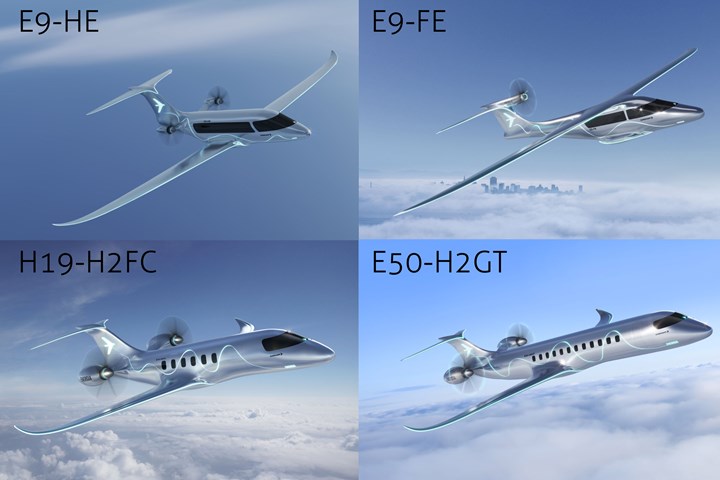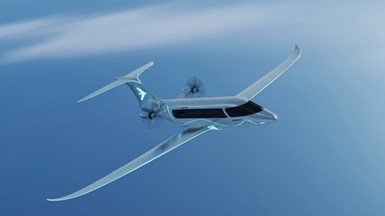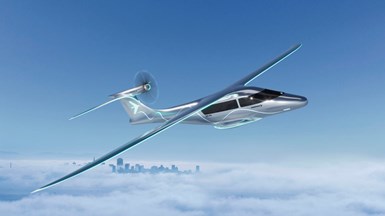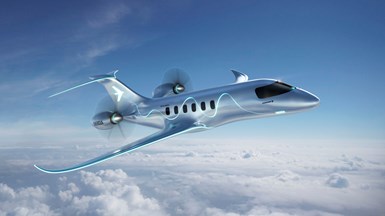Embraer unveils four Energia concept aircraft for net-zero aviation by 2050
Aircraft being developed span 9 to 50 seats and electric, hydrogen fuel cell, dual-fuel gas turbine and hybrid-electric propulsion.
On Nov. 8, Embraer (São José dos Campos, São Paulo, Brazil), the world’s third largest aircraft manufacturer, announced the Energia family of concept aircraft that it is exploring to help the industry achieve its goal of net-zero carbon emissions by 2050. The details of the Energia family — released to coincide with the COP26 climate gathering in Glasgow — were broadcast live via YouTube from Embraer’s manufacturing facility in São José dos Campos, Brazil.
The company has partnered with an international consortium of engineering universities, aeronautical research institutes and small- and medium-sized enterprises (SMEs) to better understand energy harvesting, storage, thermal management and their applications for sustainable aircraft propulsion.
The Energia family comprises four concept aircraft that incorporate different propulsion technologies: electric, hydrogen fuel cell, dual fuel gas turbine and hybrid-electric. With various combinations of range and technology, Embraer says it sees a potential market for some 4,000 airplanes.
Each aircraft is being evaluated for its technical and subsequent commercial viability.
As reported by Reuters reporters Gabriel Araujo and Tim Hepher, the two nine-seaters could be flown by a single pilot. The 19-seater is powered by hydrogen-based fuel cells and the 35-50-seater is designed to use hydrogen on short routes, backed up by sustainable aviation fuel (SAF) for extra range and emergency reserves.
As reported by Reuters, these designs are the result of work kept under wraps for two years and would address a gap between the new eVTOL or flying-taxi industry and 50-seater turboprops or small jets. Embraer believes that small regional planes will be the first to embrace breakthrough technologies like hydrogen, ahead of the larger narrow-body commercial jetliners.
“It’s a segment where we believe a lot of opportunities lie ahead,” Arjan Meijer, chief executive of Embraer Commercial Aviation, told Reuters in an interview.
Embraer said it was open to partnerships to develop the planes, which would be competing in what has historically been a volatile niche of the aircraft industry.
Reuters reports Embraer Marketing Vice President Rodrigo Silva e Souza as saying the rejigging of global supply chains and a trend towards working remotely would put greater emphasis on flying short distances.
Meanwhile, Embraer is proceeding with plans for smaller eVTOL aircraft through a spin-off called Eve Urban Air Mobility. The fully-electric, zero-emissions vertical take off and landing vehicle is being developed to enter service in 2026.
Embraer also continues to seek financial or industrial partners to help launch a proposed new turboprop, Meijer told Reuters. It has hinted at a possible decision early next year.
“We see our role as a developer of novel technologies to help the industry achieve its sustainability targets,” explained Luis Carlos Affonso, Embraer’s senior VP of engineering, technology and corporate strategy. “There’s no easy or single solution in getting to net zero. New technologies and their supporting infrastructure will come online over time. We’re working right now to refine the first airplane concepts, the ones that can start reducing emissions sooner rather than later. Small aircraft are ideal on which to test and prove new propulsion technologies so that they can be scaled up to larger aircraft. That’s why our Energia family is such an important platform.”
“We will see a big transformation in our industry towards a more sustainable aviation,” added Meijer. “With 50 years of experience in developing, certifying and supporting regional aircraft, Embraer is in a unique position to make viable the introduction of new disruptive green technologies."
Although the Energia airplanes are still on the drawing board, Embraer has already made advances in reducing emissions from its aircraft. Within its family of E-Jets, Embraer has already tested drop-in sustainable aviation fuel (SAF), as well as mixes of sugarcane, camelina plant-derived fuel and fossil fuel. The company is targeting to have all Embraer aircraft SAF-compatible by 2030.
Last August, Embraer flew its Electric Demonstrator, a single-engine EMB-203 Ipanema, 100% powered by electricity. A full electric demonstrator flew this year and a hydrogen fuel cell demonstrator is planned for 2025.
For complete information about Embraer’s Sustainability in Action initiative and specifications for each Energia concept aircraft, go to https://www.embraercommercialaviation.com/sustainabilityinaction. Also see the detailed synopsis by Graham Warwick and Jens Flottau in Aviation Week.
Related Content
Thermoplastic composites welding advances for more sustainable airframes
Multiple demonstrators help various welding technologies approach TRL 6 in the quest for lighter weight, lower cost.
Read MorePEEK vs. PEKK vs. PAEK and continuous compression molding
Suppliers of thermoplastics and carbon fiber chime in regarding PEEK vs. PEKK, and now PAEK, as well as in-situ consolidation — the supply chain for thermoplastic tape composites continues to evolve.
Read MoreThe state of recycled carbon fiber
As the need for carbon fiber rises, can recycling fill the gap?
Read MoreMaterials & Processes: Composites fibers and resins
Compared to legacy materials like steel, aluminum, iron and titanium, composites are still coming of age, and only just now are being better understood by design and manufacturing engineers. However, composites’ physical properties — combined with unbeatable light weight — make them undeniably attractive.
Read MoreRead Next
From the CW Archives: The tale of the thermoplastic cryotank
In 2006, guest columnist Bob Hartunian related the story of his efforts two decades prior, while at McDonnell Douglas, to develop a thermoplastic composite crytank for hydrogen storage. He learned a lot of lessons.
Read MoreCW’s 2024 Top Shops survey offers new approach to benchmarking
Respondents that complete the survey by April 30, 2024, have the chance to be recognized as an honoree.
Read MoreComposites end markets: Energy (2024)
Composites are used widely in oil/gas, wind and other renewable energy applications. Despite market challenges, growth potential and innovation for composites continue.
Read More





















.jpg;maxWidth=300;quality=90)









